The call of the wild spurs a lot of travelers to purchase an RV. Adventure is out there and just thinking about that perfect destination is enough to bring a smile on anyone’s face. But summer is right around the corner. The increasing heat outside spurs RVers to devise ways to keep cool. While a trip to the beach or the mountains is a great way to cool down, you still want to stay cool while driving and while parked.
Hitting the open road in the peak of the season, however, can also often lead to uncomfortable interior temperatures once you set up camp for the evening. With so many adventurers turning to solar power for an affordable, portable way to generate electricity, many people are wondering if it is possible to get enough solar power for camper-van air conditioners.
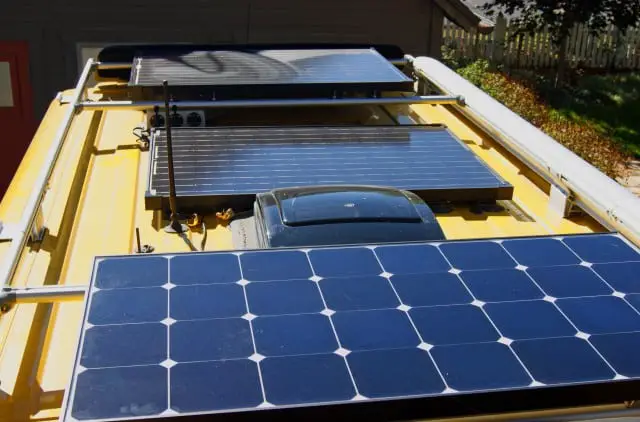
It is technically possible to power an RV air conditioner with solar panels, to generate enough power, a large number of solar panels and upgrades to the electrical system would be required. An average RV air conditioner requires around 1800 watts of electricity to start up and 650 watts per hour to maintain use and cool down the camper-van.
How to Size Your Solar Power for RV Air Conditioners.
There are three crucial components of a solar power system that need to be considered and sized if you are hoping to utilize solar power for your RV`s air conditioning: batteries, solar panels, and inverters.
Sizing is the most important factor in how your solar power will function with your RV. The three components that require sizing attention are solar array, battery bank, and your inverter.
All three of these things are required to be extremely large. It would not be simple to supply that much energy. To do this, your battery bank, inverter, and the solar array would need to be larger than average.
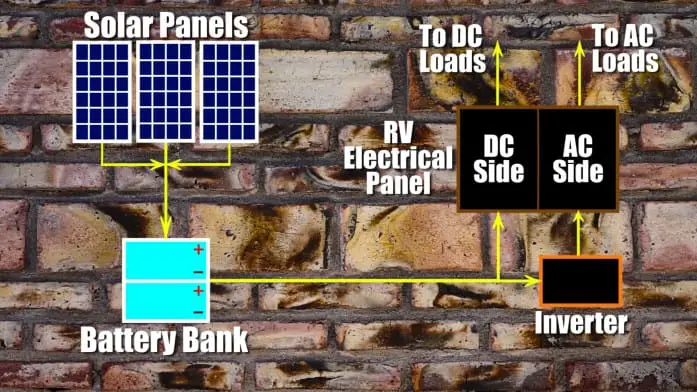
Minimum Battery Bank Size for RV Air Conditioners
As discussed above, running your RV air conditioner requires a lot of power. The larger your battery is though, the more energy storage you will have available to power your RV AC. When it comes to options, we usually recommend stringing together a few lithium-ion batteries, such as the Renogy 12V, for your solar battery bank.
Cheaper options, such as lead-acid batteries, become damaged if they are fully drained, whereas most lithium batteries are built to be used to their full potential. When running an AC unit in your RV, you will want to use every Amp-hour you can to keep your RV cool. Because air conditioning units can use over 100 amps each hour, for overnight use, we recommend a battery or battery bank with an absolute MINIMUM of 700Ah.
Minimum Solar Panel Array Size for RV Air Conditioners.
Unfortunately, solar panels and cool inside temperatures operate with completely separate goals in mind. Whereas your RV is more likely to stay cool if it is in the shade, solar panels require direct sunlight to produce electricity. With this in mind, you will want to have a
For an average-sized RV air conditioner (around 13,000 BTU’s), we would recommend a minimum of 1500 watts of solar power. If you’re in a school bus or an RV with ample roof space, you could consider a set of 16 x 100 Watt Solar Panels such as these monocrystalline ones.
Or if you are a bit more limited on space, you may want to consider looking into larger, high-efficiency solar panels generally found in residential homes.
Keep in mind that anything less than 1000 to 1500 watts worth of solar panels, and the battery storage to match, will not be enough to power most RV air-conditioners.
Check out this WindyNation 200 Watt
Minimum Inverter Size for RV Air Conditioners.
Even if you have an enormous battery bank and plenty of solar input, to use solar power for an RV air conditioner, you will need to have an inverter large enough to handle the unit’s electricity demand.
An inverter’s job is to convert the DC electricity produced by solar panels into usable AC electricity (the kind traditionally found in homes) to run your electronic devices. As mentioned earlier, an average-sized AC unit for an RV can require around 1800 watts of electricity to get up and running.
When sizing an inverter, we always recommend that you leave as much wiggle room as possible, especially if you are going to be running other devices such as lights or phone chargers while your AC is on. Therefore, we recommend an absolute minimum of 2500 watts for the size of your inverter.
For a small solar power RV air conditioner system, this 3000 Watt inverter from AIMS should be powerful enough to keep your unit running. However, knowing the required wattage for your specific AC to run is very important when purchasing your inverter.
How Many Solar Panels Do You Need to Run an RV Air Conditioners?
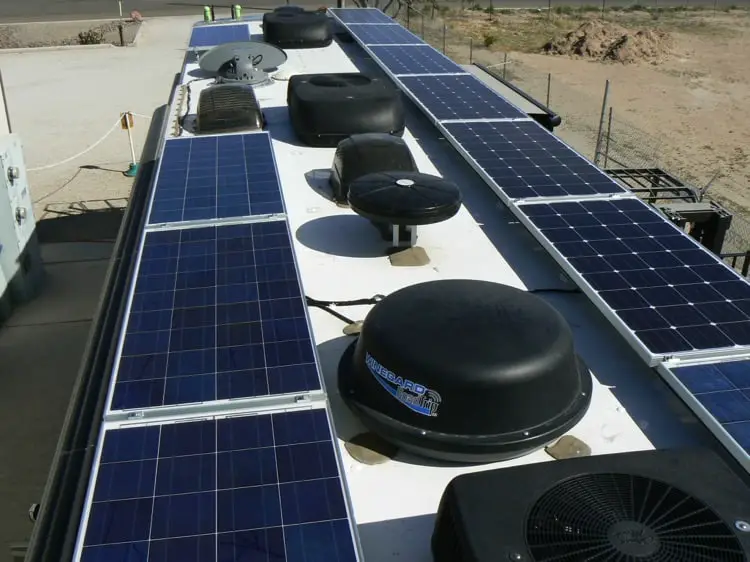
This is where financial investment can start to add up. To run an AC off solar power for an extended amount of time, the AC will essentially need its solar setup. As an example, let’s consider the amperage draw of our RV AC and how many hours per day we plan to run the unit.
Example RV AC Daily Amperage Draw
150 amps/hr x 5 hrs/day= 750 Ah/day
The goal is to replenish this energy with solar panels, or at least get close. We’ll figure there’s an average of 6 usable hours of sunlight per day for our solar panels. Over these 6 hours, we want the panels to produce a total of 750 amps of energy to replenish the power drawn by the AC.
By this estimate, we’ll need about 2,500 watts of solar panels just to break even on the AC unit’s consumption. This doesn’t include the solar power needed to run anything else in the RV. We’ll need about twelve 200-amp hour solar panels and one 100-amp hour panel to run the AC.
This kind of setup can get pricey pretty quickly! Not to mention, there is only so much room on top of your RV for solar panels.
How many watts does it take to run an RV air conditioner?
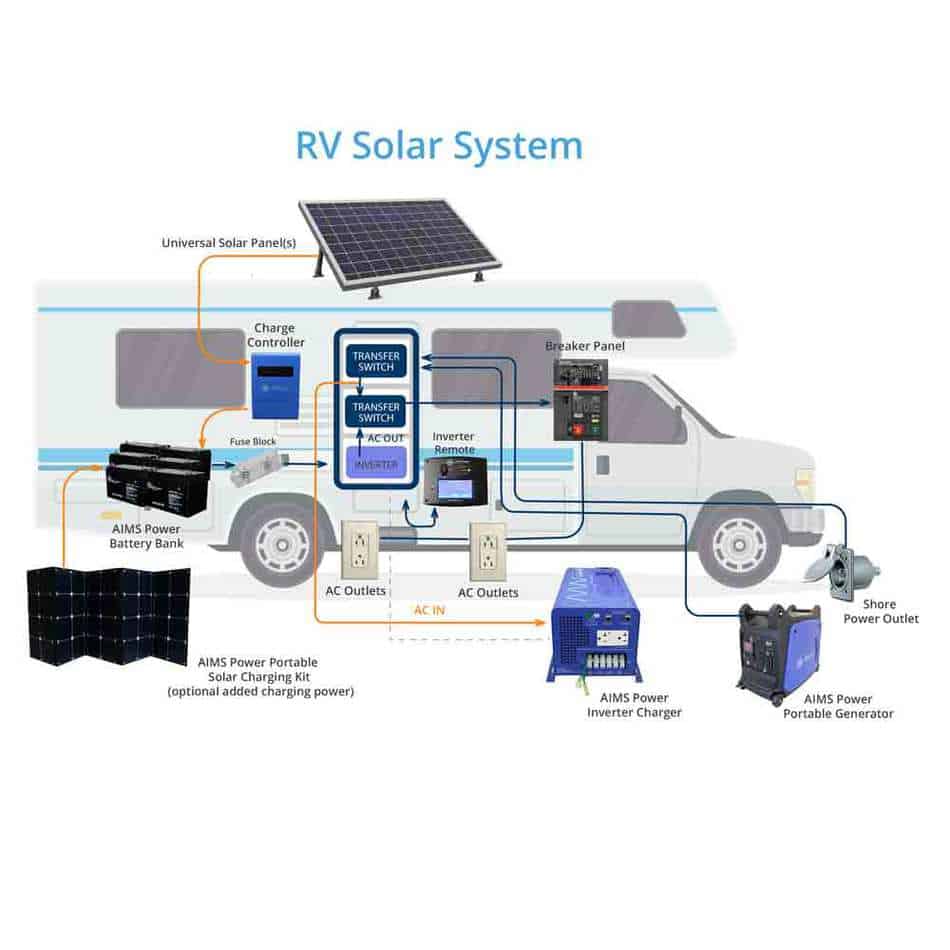
For an 8,000 BTU RV air conditioner, 1,700 watts is required for start and 600 once running. For a 10,000 BTU RV air conditioner, 2,000 watts is required to start up and 700 once running. For a 15,000 BTU RV air conditioner, 3,500 watts are required for start-up and 1,500 once running.
How Much Does It Cost to Run an RV AC Off Solar Power?
700 Ah Lithium-Ion Battery Bank – $7,200
2,500W Solar Panels – $7,800
3,000W Inverter – $1,000
Total = $ 16,000
How to Select the Best RV Air Conditioner
There are a lot of options out there. Here are some essential tips for choosing the very best portable RV air conditioner for your needs.
There are plenty of factors to consider when choosing a new RV air conditioner. But, the top three factors that most people may overlook are:
Shape
Pick one with a sleek, aerodynamic shape. This way, your AC unit will be shaped to resist wind drag which helps your vehicle from being slowed down in severe weather and increases fuel efficiency.
BTU also is known as British Thermal Units
Before buying an air conditioner, it’s essential that you know the amount of BTU needed to cool your RV. This number is based on the square footage of the RV. A large RV needs over 18,000 BTU to assure a continuous cooling of the space. You don’t want to buy an AC unit that is too weak and can’t sufficiently cool your RV.
Refer to this chart:
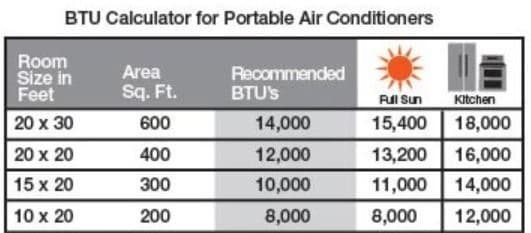
Easy Installation
The perfect air conditioner unit has to be light-weight and slim for a hassle-free DIY fitment into the RV.
What Portable RV Air Conditioner Suits Your Style?
Rooftop Air Conditioner
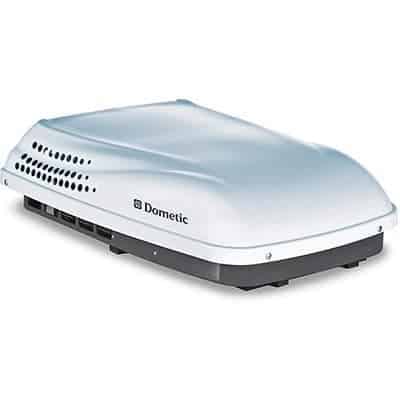
This is a popular choice. Because it resides on the roof of the RV, this air conditioner doesn’t take up extra space in the RV. Most rooftop air conditioners have between 5,000 and 15,000 BTU/Hour. This is a modest number considering that more than 30% of the energy is consumed through the vents. A single rooftop air conditioner can cool an area 10 feet by 50 feet.
The unit is cooled by the outside air and is powered through your RV. Depending on the size of the unit it can use a ton of power, so this is not the best choice for those who are conserving energy or like to camp off the grid.
Rooftop air conditioners can also be costly to repair. Keeping the air conditioner on the roof exposes it to the moist air, leading to rust and possible bacterial growth.
A Vent Free Portable Air Conditioner
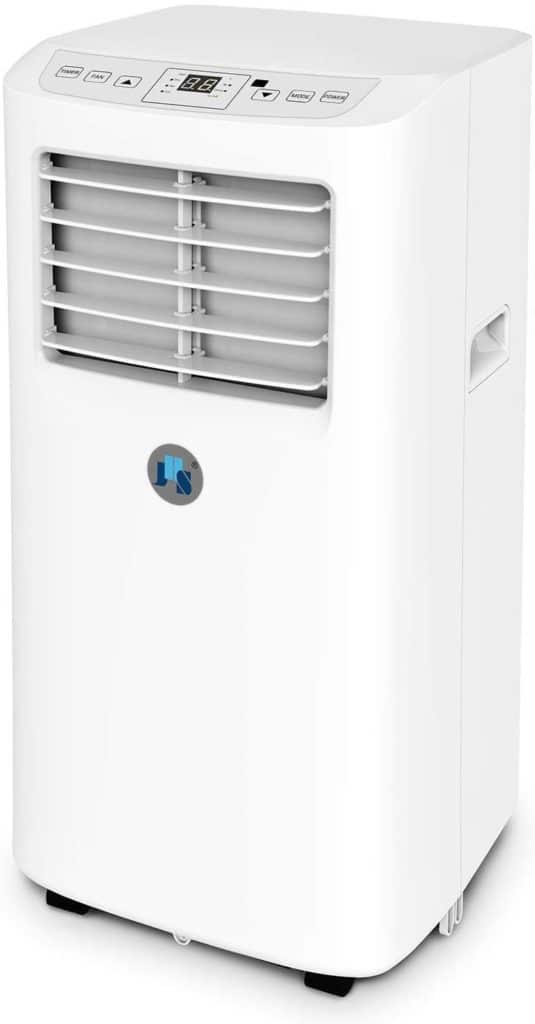
This unit functions as a portable air conditioner but is smaller in size and the design can be rather captivating. A vent-free air conditioner is also called a “swamp cooler” due to its unique moist air ventilation. No refrigeration process is used to cool the air. The air conditioner uses evaporated water that is released in the dry air, quickly chilling the room.
On the plus side, it doesn’t consume very much energy since you only have to power the vent, and it doesn’t take up much space. On the negative side, you will need to improvise a hose since sometimes the water is not completely evaporated. This can cause water to leak through the device and all over the floor.
There is one small problem. The unit can only be used in climates with relatively dry heat. Humid weather will counter the cooling effect and nullify it. For a greater effect, the air conditioner’s evaporation process needs to blend with the dry atmosphere to form the chill effect.
The Portable RV Air Conditioner
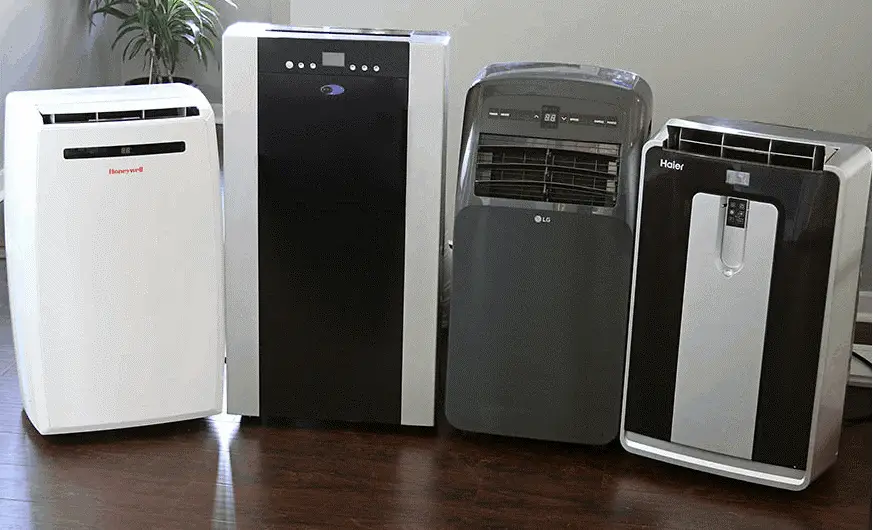
This device uses one or two holes to ventilate the hot air between the device and outside. It comes with adjustable frames that are placed under the window to keep the hoses in place. Be careful if you use the single hose air conditioner since there is a strong possibility that hot air will come inside the room due to improper ventilation.
Portable RV air conditioners can be cheap, but they take up a ton of space. A lot of customers point out that these types of units are not very efficient and can sometimes be extremely costly. Also, the compressor of the conditioner is inside the room so you will have to live with an annoying cooling sound for the rest of your road trip.
The RV Window Air Conditioner

Possibly the best choice in portable RV air conditioners. The window air conditioner offers great cooling capacity in a small package.
It doesn’t take up space (since it’s easily installed outside of the window), and it’s easy to maintain. If you search hard enough, you can find mini window air conditioners as small as 14 inches that open horizontally instead of vertically. Plus it houses all the necessary cooling components within one box (compressors, vents, etc) so noise pollution isn’t a problem.
Although all of the units have advantages and disadvantages, I would personally go for the window air conditioner.
What to Consider before installing solar panels to power an RV AC unit.

A van`s roof is seldom an uninterrupted space. There are always AC shrouds, vent pipes, TV antennas, fan shrouds, Radio Antennas, WIFI antennas, and range extenders to consider.
Roof Space Requirements
The total self-contained roof solar must be less than or equal to the total available square footage of your RV roof. It is not ideal to cover most of these items with panels.
Each
It may be a good option to buy a soft start inverter. This will allow you to have a smaller inverter to supply power to your RV’s air conditioner.
The paint of the RV
The color of your RV is an often-overlooked factor in determining whether or not you need a second air conditioner. Take a look around your local RV dealer – there’s a reason why most of the RVs you see are white, beige, or a light tan. They reflect the sun’s rays, which absorbs much less heat and results in a cooler RV.
Your location
If your idea of a long-distance RV vacation is going up to above average hotter regions, there’s no need to factor location into your decision on whether to purchase a second air conditioning unit.
A second air conditioner can be enormously handy if you’re planning on traveling around – even if you’re not using it all the time.
Alternatives to RV Air Conditioners
If you do not have the roof space or the budget for a solar-powered RV air conditioner, there are a few options you can explore to keep your mobile home’s interior cool. You can always:
- Purchase a swamp cooler.
- Run your vehicle’s air conditioning while the engine is on.
- Plug into RV park hookups.
- Or park in the shade and use a few high powered fans.
Final Thoughts about Powering an RV Air Conditioner with Solar Panels
Powering an RV air condition unit of between 10000 and 35000 BTUs is possible. However, the number of panels needed to power the rest of the RV, let alone keep the AC unit running all day, would be pretty high.
If you think that solar panels are the best way to power your RV’s air conditioner, just remember to keep your usage down. More than four or five hours a day and you won’t have any power left for anything else. This includes the fridge and other essential appliances.
This boils down to two things-is it worth investing in all the equipment and also do you have a large enough campervan that can accommodate the large setup of solar panels and battery banks
If you answer yes to all the questions-then go for it and enjoy all the creature comforts of van-life! It also depends on the size of your RV. If your RV is not large enough to accommodate all of the solar panels, then this is probably not an option for you.
After seeing what’s involved, many campers opt for the easier, more cost-effective alternative of a good old generator.
You can also simply use solar to supplement other energy sources. For instance, if you’re plugged into a 15-amp outlet, you may choose to use a
Related Articles: Does the RV Have To Be Level To Run the AC? Step-by-step: How to quieten a loud RV air conditioner
